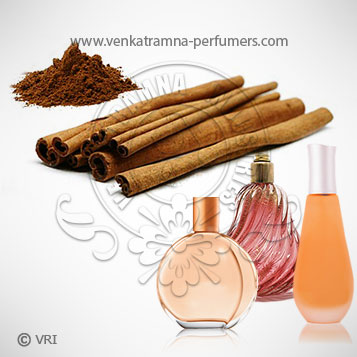
| Botanical Name | Cinnamomum zeylanicum |
| Common Name | Cinnamon Oil, Cinnamon Bark Essential Oil |
| Country of Origin | India |
| Solubility | soluble in alcohol, insoluble in water |
| Specific Gravity | 1.03000 @ 25.00 °C. |
| Optical Rotation | 0° to 2° @30°C |
| Refrective Index | 1.59200 @ 25.00 °C. |
| PlantPart | Bark |
| Bland With | Lavender, Frankincense, Cedarwood, Citrus Oils, Elemi, Ylang Ylang and other floral notes, Benzoin. |
| CAS No | 8015-91-6 |
| Flash Point | 98 °C |
| Extraction Method | Hydro distilled |
Known by the botanical name Cinnamomum zeylanicum, Cinnamon Bark extract is taken from the Bark part of the tree through Steam Distillation process. The cinnamon tree is an evergreen native to China & Vietnam and has shiny, leathery green leaves as well as small, white flowers with oval shaped purple berries. The genus Cinnamomum (Laureaceae family) consists of 250 spices of trees and shrubs distributed in south-east Asia, China, and Australia. It is a small, evergreen tree, 10–15 m tall. The bark is widely employed as a spice, its leaves are ovate-oblong in shape, and 7–18 cm long. The flowers, arranged in panicles, have a greenish color and have a rather disagreeable odor. The fruit is a purple 1 cm berry containing a single seed. It is found in tropical rain forests, where it grows at various altitudes from highland slopes to lowland forests and occurs in both marshy places and on well-drained soils. However, in latitudes with seasonal climatic conditions, they become exceedingly rare. There are two main varieties of cinnamon namely the Ceylon or true cinnamon (Cinnamon zeylanicum) and cassia (Cinnamom aromaticum). C. zeylanicum is native to Sri Lanka and tropical Asia and exotic to several African countries, such as Comoros, Ghana, Madagascar, Mauritius, Nigeria, Seychelles, Sierra Leone, Tanzania, and Uganda. The most important cinnamon oils in word trade are those from Cinnamomum zeylanicum, Cinnamomum cassia, and Cinnamomum camphora. The cinnamon essential oil composition varies depending on the geographical origin of the spice and the processing conditions. Likewise, it has been detected slight differences between the composition of volatile oils from buds, flowers, and fruits from C. zeylanicum. Jayaprakasha et al. (2000) reported that the oil from buds contains higher amounts of mono and sesquiterpenes, and most characteristic compounds such as cinnamaldehyde are found in flowers and fruits and in lower amounts in buds
The barks are commonly used in Cameroon as spices and for the treatment of cardiovascular diseases and cancers. Cinnamaldehyde (1; 75%) and camphor (56%) are the major compounds in oil and stem bark, respectively. Cinnamon extract inhibits the formation of toxic Aβ oligomers and prevents the toxicity of Aβ on neuronal PC12 cells. Oral administration of cinnamon extract induced to the reduction of plaques and improvement in cognitive behavior to aggressive Alzheimer's disease transgenic mice. The prevention or treatments of Alzheimer’s disease are mostly based on drugs inhibition of cholinesterase function or formation of amyloid plaque. Pathologies and dementias of the nervous system, such as Alzheimer’s disease and Parkinson’s disease (Lei et al., 2010) can result when tau proteins (tau proteins are proteins that stabilize microtubules) become defective and no longer stabilize microtubules properly. Chemicals able to prevent the tau aggregation may be a key factor in the development of new drugs.
Color : Yellow color with earthy, woody and spicy odor,
Aroma : Warm, spicy scent that is somewhere between clove and cinnamon.
Primarily contains 35 – 60% thymol, p-cymine (10-16%), a-terepinene (10-16%), ß-pinene (4-5%) and dipenene (4-6%), Cinnamon bark oil; cinnamaldehyde, eugenol, benzaldehyde, pinene, cineol, phellandrene, furfurol, cymene, linalol, Cinnamon, leaf oil; eugenol acetate, cinnamaldehyde, benzyl benzoate, linalol.
Cinnamon, the eternal tree of tropical medicine, belongs to the Lauraceae family. Cinnamon is one of the most important spices used daily by people all over the world. Cinnamon primarily contains vital oils and other derivatives, such as cinnamaldehyde, cinnamic acid, and cinnamate. In addition to being an antioxidant, anti-inflammatory, antidiabetic, antimicrobial, anticancer, lipid-lowering, and cardiovascular-disease-lowering compound, cinnamon has also been reported to have activities against neurological disorders, such as Parkinson’s and Alzheimer’s diseases. This review illustrates the pharmacological prospective of cinnamon and its use in daily life. Cinnamon Bark Essential Oil in Pharma The barks are commonly used in Cameroon as spices and for the treatment of cardiovascular diseases and cancers. Cinnamaldehyde (1; 75%) and camphor (56%) are the major compounds in oil and stem bark, respectively. Cinnamon extract inhibits the formation of toxic Aβ oligomers and prevents the toxicity of Aβ on neuronal PC12 cells. Oral administration of cinnamon extract induced to the reduction of plaques and improvement in cognitive behavior to aggressive Alzheimer's disease transgenic mice. The prevention or treatments of Alzheimer’s disease are mostly based on drugs inhibition of cholinesterase function or formation of amyloid plaque. Pathologies and dementias of the nervous system, such as Alzheimer’s disease and Parkinson’s disease (Lei et al., 2010) can result when tau proteins (tau proteins are proteins that stabilize microtubules) become defective and no longer stabilize microtubules properly. Chemicals able to prevent the tau aggregation may be a key factor in the development of new drugs. Essence of Cinnamon Bark Essential Oil Essential oils of cinnamon bark and leaf are widely used in food flavours, cosmetics and pharmaceuticals. Cinnamon is mainly used in the aroma and essence industries due to its fragrance, which can be incorporated into different varieties of foodstuffs, perfumes, and medicinal products. The Oil is rich in monoterpenoids and phenyl propanoids. (E)-Cinnamaldehyde is the main component of cinnamon bark oil and eugenol the main component of the leaf oil. Benzyl benzoate chemotypes of cinnamon bark and leaf oils and linalool chemotype of cinnamon leaf oil were also reported. Essential oils of other parts such as fruit, fruit stalk, flower, bud, leaf petiole of cinnamon have also reported having medicinal and pharmacological benefits.